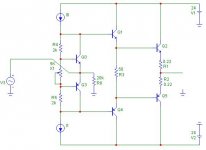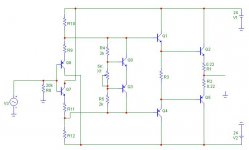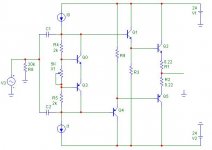I have had an idea in my head for some time to try to put together an unity gain push pull output stage running in class A. There are numerous ways to make a good voltage amplifier and to make a good output stage. It's tricky to make them in one. So this output stage would leave a room to experiment with VA configurations sepparately.
***
The recent complex emitter follower thread gave some food to the tought again...
Basicly what I have in mind is an output stage that has only one goal - to provide enough power to the load.
It seems that the best linearity/stability would be achived with simple emitter follower stages. So If I'll take an output stage and driver stage and run both with high Iq it should be possible to get quite low distortion figures....
But now the question I have a problem finding a solution to - how to inject the input signal into this output stage and at the same time make no compromises on quality and keep everything as simple as possible.
So, I have at the moment 3 versions that I think show potential
Version 1 - Can this be done or is there any downside that I don't see?
Version 2 - add one more stage, I would like to avoid this if possible
Version 3 - adds capacitors to signal chain, I would like to avoid this also if possible. This version also shows different driver stage. Self shows this in his book but says he can't find any good reason to use this....
***
So please comment on these or the whole chain of tought. I have two monoblock cases with LC filtered power supplies providing +/- 24V and a good heatsink with 0,33K/W and some Sanken transistors 2SC2837/2SA1186 and 2SC4883/2SA1859 for drivers on hand and if I find some good solution I would try it out....
The transistors are bjt for now just because I have them in some box. I would use MOSFET if you guys think there is hope for better results.
Ergo
***
The recent complex emitter follower thread gave some food to the tought again...
Basicly what I have in mind is an output stage that has only one goal - to provide enough power to the load.
It seems that the best linearity/stability would be achived with simple emitter follower stages. So If I'll take an output stage and driver stage and run both with high Iq it should be possible to get quite low distortion figures....
But now the question I have a problem finding a solution to - how to inject the input signal into this output stage and at the same time make no compromises on quality and keep everything as simple as possible.
So, I have at the moment 3 versions that I think show potential
Version 1 - Can this be done or is there any downside that I don't see?
Version 2 - add one more stage, I would like to avoid this if possible
Version 3 - adds capacitors to signal chain, I would like to avoid this also if possible. This version also shows different driver stage. Self shows this in his book but says he can't find any good reason to use this....
***
So please comment on these or the whole chain of tought. I have two monoblock cases with LC filtered power supplies providing +/- 24V and a good heatsink with 0,33K/W and some Sanken transistors 2SC2837/2SA1186 and 2SC4883/2SA1859 for drivers on hand and if I find some good solution I would try it out....
The transistors are bjt for now just because I have them in some box. I would use MOSFET if you guys think there is hope for better results.
Ergo
I forgot to mention that I plan to run the output transistors with Iq of about 1.5A each. They have a beta of 50. The predrivers have a beta of 160.
What would be a good value for Iq for the driver transistors?
Ergo
What would be a good value for Iq for the driver transistors?
Ergo
Hi ergo,
have a look at
http://www.pha.inecnet.cz/macura/next.htm
and you will find a solution of what you are looking for. The THD and IMD measurements are shown. It not only measures, but also sounds phantastic🙂
Pavel
have a look at
http://www.pha.inecnet.cz/macura/next.htm
and you will find a solution of what you are looking for. The THD and IMD measurements are shown. It not only measures, but also sounds phantastic🙂
Pavel
Your solution is quite what I have in mind.
Is this output configuration stable or is it stable only with C3 C4 added?
Ergo
Is this output configuration stable or is it stable only with C3 C4 added?
Ergo
stability
Ergo,
yes, it is stable with C3 and C4, and also a Boucherot network (R16, C5) right at the binding posts (speaker output terminals of the amp). Proper current paths are necessary, speaker return wire must be connected to the 0V point of the power supply. Iddle current is measured on R12, R13 and can be changed by R5, R6.
Pavel
Ergo,
yes, it is stable with C3 and C4, and also a Boucherot network (R16, C5) right at the binding posts (speaker output terminals of the amp). Proper current paths are necessary, speaker return wire must be connected to the 0V point of the power supply. Iddle current is measured on R12, R13 and can be changed by R5, R6.
Pavel
Sziklai connected Output
Hi Pavel,
May I ask what is advantage of the Sziklai connected outputtransistors over Darlington connected? Just curious,
😕
PMA said:Hi ergo,
have a look at
http://www.pha.inecnet.cz/macura/next.htm
and you will find a solution of what you are looking for. The THD and IMD measurements are shown. It not only measures, but also sounds phantastic🙂
Pavel
Hi Pavel,
May I ask what is advantage of the Sziklai connected outputtransistors over Darlington connected? Just curious,
😕
Re: Sziklai connected Output
Rod Elliot also has a few words on the subject...Link...
Read here . His description is using a small signal config, but the concept is the same.Elso Kwak said:
Hi Pavel,
May I ask what is advantage of the Sziklai connected outputtransistors over Darlington connected? Just curious,
😕
Rod Elliot also has a few words on the subject...Link...
Hi Elso,
for my circuit without global NFB it is:
- better linearity,
- only one Vbe voltage, thermal stability is kept by drivers, input transistors and 0.1 Ohm resistors,
- local NFB resulting in good linearity and lower THD/IMD.
Pavel
for my circuit without global NFB it is:
- better linearity,
- only one Vbe voltage, thermal stability is kept by drivers, input transistors and 0.1 Ohm resistors,
- local NFB resulting in good linearity and lower THD/IMD.
Pavel
- Status
- Not open for further replies.
- Home
- Amplifiers
- Solid State
- unity gain push pull output stage


